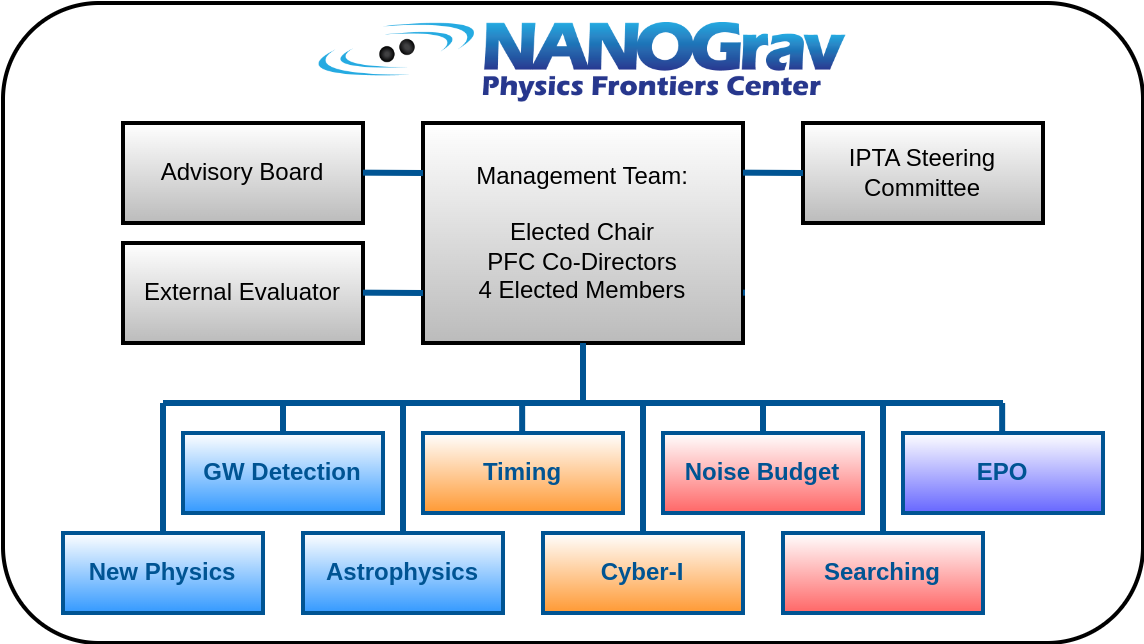
In order to best facilitate our goals, NANOGrav is partitioned into teams/boards/groups based on their charge. The above chart showcases this structure. Research, planning, and outreach work takes place in various working groups (WGs), shown at the bottom of the chart in blue. WGs meet regularly, typically weekly, and report to the Management Team (MT) at monthly telecons. The MT consults with the Advisory Board twice a year on issues relating to scientific progress and management, and is advised by an external evaluator on broader impacts progress. NANOGrav liaises with the IPTA through the IPTA steering committee.
Management Team
Structure
Consists of the two PFC Co-Directors, an elected NANOGrav Chair, and four elected members. The MT holds open meetings (unless closed meetings are deemed necessary) weekly. They will be assisted locally by program coordinators to manage all financial, contractual, and logistical aspects of the Center. The Chair and other members of the MT are elected on two-year cycles.
Charge
The MT will oversee all NANOGrav activities and meets regularly to review progress toward NANOGrav PFC goals, personnel and resource allocation, membership and/or authorship issues, outreach efforts, and status of our computational and telescope resources. There are clearly distinguished roles for the Co-Directors and Chair: Siemens taking primary responsibility for budget allocations and reporting, McLaughlin taking primary responsibility for tracking of PFC milestones, and Ransom (and subsequent chairs) taking primary responsibility for managing memberships and communicating with the broader community.
Advisory Committees
Advisory Board
Structure
Advisory Board (AB) members serve for three years, and new members are chosen to best advise on current PFC activities and challenges. NANOGrav PFC senior personnel will meet twice a year with the AB.
Charge
The AB evaluates the management, science progress, outreach and diversity efforts, risks, and future prospects of the NANOGrav PFC. The AB plays a critical role in the development and growth of both the scientific vision and organizational framework of the NANOGrav PFC.
External Evaluator
Structure
Hired consultants from The Mark on an as needed basis contract (based on the below charge).
Charge
The impacts of student workshops and the STARS program on undergraduates will be assessed through external evaluation. PFC demographics and climate data will be collected to help us meet diversity goals. Evaluation results will be documented in annual reports to the MT.
IPTA Steering Committee
Structure
Consists of seven rotating members, two from each of the three PTA collaborations and a Chair. They meet monthly via video-con and are also joined by one member from each of the nascent PTA groups in China, India, and South Africa (and currently another member representing MeerTime).
Charge
IPTA activities are coordinated by an IPTA Steering Committee (IPTASC). The Steering Committee also organizes the creation of combined IPTA datasets and GW detection searches in those datasets. The NANOGrav representatives on the IPTASC will serve as liaisons for NANOGrav with the IPTA.
Working Groups
Structure
Working Groups (WGs) consist of 10 to 30 members and meet regularly, typically weekly, on video-conferences, to discuss progress on and impediments to research, outreach milestones, and upcoming publications. They will lead the overall development of milestones, WG vision, and track the milestones and overall progress. Chairs will report to the NANOGrav PFC management team and the collaboration at large at monthly all-hands video-cons, and two in-person meetings per year.
Gravitational Wave Detection
The GW Detection WG will develop, test, and deploy algorithms to search for and characterize gravitational waves.
Astrophysics
The Astrophysics WG will model GW signals of of supermassive black hole binary origin and carry out multi-messenger studies.
New Physics
The New Physics WG will model GW signals from sources other than binaries, of cosmological or fundamental-physics origin.
Timing
The Timing WG creates pulsar timing data sets for detecting gravitational waves and other purposes. It decides on observing strategies and source lists, makes observations, reduces data, develops timing and noise models for all pulsars, creates and publishes data releases, explores new data analysis techniques, undertakes ancillary astrophysics studies using the NANOGrav data, and develops computer code for all of the above purposes.
Cyber-Infrastructure
The Cyber Infrastructure (Cyber-I) WG will work on data management for NANOGrav and providing cyber-infrastructure support including: meeting support; container, notebook and cluster processing environment; website management; and resources for document and code management.
Noise Budget
The Noise Budget WG will model and mitigate noise processes.
Searching
The Searching WG will work to expand the NANOGrav detector by searching for new millisecond pulsars to add to the timing array.
Education & Outreach
The Education and Outreach WG will address NANOGrav PFC broader impacts by involving students at all levels in low-frequency gravitational wave astrophysics with pulsar timing arrays and establishing collaboration policies that ensure broad participation by diverse groups.